There aren’t many gun enthusiasts across the planet who aren’t familiar with this powerful firearm. It is a gas-operated semi-automatic rifle invented by Eugene Stoner in the 1950s. The weapon was designed for the U.S military.

Today, it is the single-most popular firearm sold across the country. The weapon’s popularity has made it appear on big screens as well. This compact weapon is probably one of the most famous rifles in the whole world.
If you’ve just bought your AR15, here’s our guide on how to sight in AR15
How to sight in AR15?
Step 1: Gather your tools
- Rifle and ammo
- Target board with a target attached
- Staple gun
- Marker (Sharpie)
- Laser bore sighter
- Hearing and eye protection
- Shooting bench or table
- Tape measure
- Sandbags
- Gun rest/clamps/vice
Step 2: Bore sighting
Bore sighting is simply the technique to get a rough idea of the point of impact once you shoot them through your weapon. Due to many complications, the hitpoint of the bullet and the reticle on your scope may point to different areas.
Bore sighting will allow you to align your reticle with the bore of your rifle and make sure you can hit the paper once you go to the shooting range for a bit more fine-tuning.
Here’s how to boresight an ar 15. The easiest way is to use a laser bore sighter that projects a high-precision laser beam on the target so you can align your reticle with the laser beam.
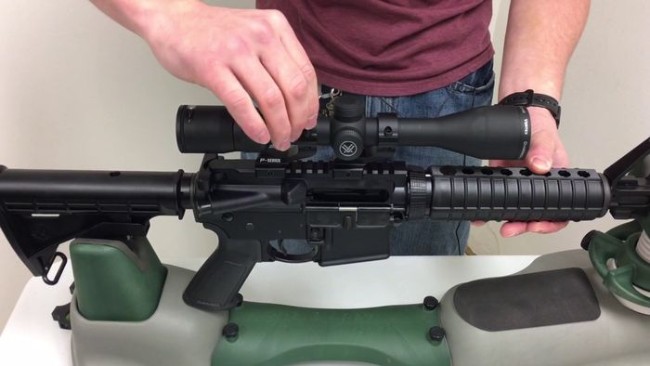
The first step to bore sight your rifle will be to set up a target 25 yards away from where you plan to shoot from. Place the target board and try to see the target through your scope. Once you are aiming at the bullseye, shoot one round to see where the bullet hits.
The bigger your target board and paper, the better. We recommend that you use a 3’x3’ cardboard box with a bullseye that is the size of a golf ball. Most likely the bullet will hit a couple of inches further from where you targeted. The next job is to align the reticle with where the bullet landed.
Step 3: Rough adjustment
To align the reticle of your scope with the actual line of fire, you’ll need to make some adjustments to your scope. Every type of scope comes with two turrets that you can turn to adjust the scope.
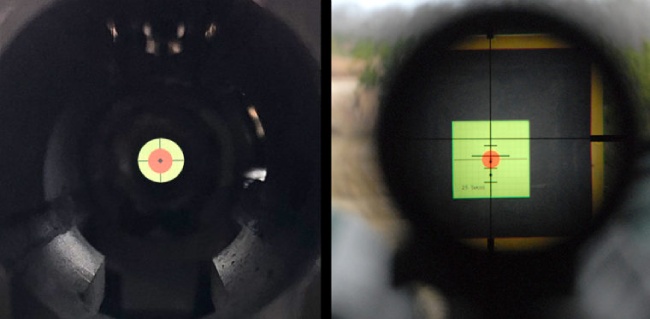
You’ll need to turn the elevation turret to move your reticle up and down and the windage turret to control the horizontal movements. You don’t need to be super accurate on the first try. Just roughly adjust the turrets so you can get your shots on paper. Fine-tuning comes later.
Just make sure you align the crosshair of your scope with the bore of the rifle and hit pretty close to the bullseye.
Step 4: Secure the firearm
The rest of sighting in an AR-15 rifle should take place on a shooting range. Don’t try to shoot standing because you’ll be needing your rifle to be steady and securely locked in a place. Try using a shooting bench or simply lie on the ground.

You can use vices, clamps, gun rests, and even sandbags to secure your AR-15. Once you get into a comfortable shooting position, it’s time to secure the rifle. The rest should be steady and level. The target board and paper need to be placed 100 yards (ideally) from you.
Step 5: Shoot a group
Once you are ready, fire a group of 3 shots at the target. In case you’re still not on the paper (very rare), you may need to redo the bore sighting till you’re actually on paper.
The group of bullets doesn’t need to hit the same spot. If they all land on paper, that’s more than enough.

Once the shooting is done, check out the target paper and mark the shots with a sharpie. Now, measure the distance between the shots with a tape measure.
Each shot ideally should be a couple of inches from each other. If not, adjust your rifle and fire another group.
Step 6: Fine adjustment
Once you’re done with the measurements, you should have the distance from the bullseye to the center of your groups. That distance will be crucial for this step. You’ll need to fine-tune your reticle and align it with the bullseye with respect to your group’s center.
For example, If the center of your group shot is 2 inches right and 3 inches up from the bullseye, You’ll need to move the bullet’s POI the exact same amount in the opposite direction. As for our example, you’ll need to move the bullet’s POI 3 inches down and 2 inches to the right.
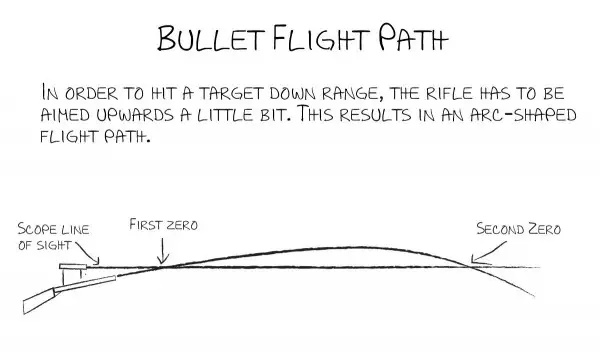
Once all the adjustments are made, fire another group and measure the result. This should get you dead center with the bullseye at 100 yards. Repeat the process until you are satisfied with the result.
Step 7: Optimal zero
And there you have it. Your AR-15 is perfectly sighted-in at 100 yards. You can also zero (sight in) your rifle at 200 years. The 25-100 yards range is the optimum choice for many professional shooters.
Keep in mind that, once you sight in your AR-15 at 100 yards, your shots will be dead on at 100 yards, a bit high at 50 yards, and a bit low at 200 yards.
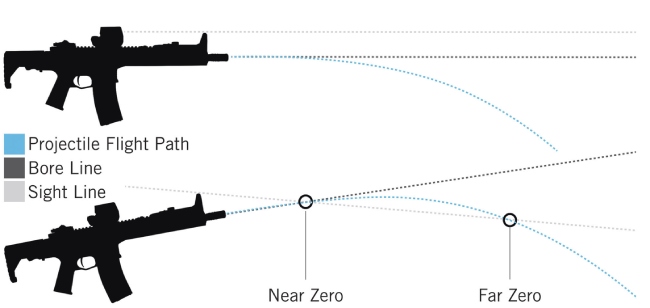
The distance you should be zeroing your rifle will depend on the distance your scope can cover. This will give you the optimum setting for hunting, defense, and target shooting.
Once every shot hits exactly where you want it to, you’ve reached the optimal zero for your AR-15.
How to sight in Ar-15 with iron sights?
In case you don’t have a scope attached to your AR-15, you can also use the iron sight. Here’s how to go about the process of zeroing iron sights AR-15:
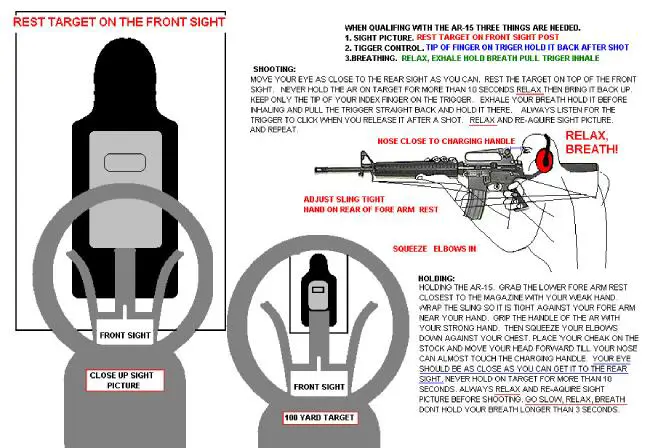
Your first job will be to align the two iron sights with each other. There will be adjustable turrets beside. Use the turrets to align the sights with each other. Once finished, align the final sight with the target.
The AR-15 comes with two aperture sights named the “Peep” and the “Ghost ring.” They usually have different sight ins that differ 2.5 inches from each other at 100 yards.
The ghost ring enables quick firing at 0-200 yards and is used with a target focus. What that means is your focus should be on the target, not the sight. For longer distances, focus on the front sight and ignore the rear one.
Once you feel that the target is just above the front sight, make some group shots. The rest of the process of how to sight in AR15 is pretty much the same as mentioned above.
FAQs
1. Is the AR-15 illegal?
Ans: No. Though the rifle was banned by The 1994 Assault Weapons Ban, the ban expired after 10 years and now it’s legal in most states. However, AR-15 is still under restriction in some states only to ban the semi-automatic, 30-round-magazine configuration.
2. Is the AR-15 an “assault rifle?”
Ans: No, despite what many believe, the AR-15 can’t be categorized as an “assault rifle.” Assault rifles are select-fire, fully automatic weapons that are in service with military, police, and defense organizations. The AR in the AR-15 stands for “ArmaLite Rifle” and is a semiautomatic rifle.
3. What is the AR-15’s effective range?
Ans: In between 400-650 yards, the AR-15 offers incredible accuracy and considerably less recoil energy over a vast range. On expert hands, this powerful weapon can hit a target from over 850 yards or even further.
4. Is the AR-15 a good hunting rifle?
Ans: Yes. Its high caliber, less recoil, lighter weight, and high accuracy have made the AR-15 a great choice for hunting. These versatile weapons are widely used in the hunting community to harvest almost any North American game.
5. Can I use backup sights with an optic on my AR-15?
Ans: Yes, backup or flip-up sights are commonly used in conjunction with optics on AR-15 rifles. They serve as a secondary aiming option in case the optic becomes nonfunctional or if you remove it. Backup sights can be flipped up into position when needed and folded down when not in use, allowing for a seamless transition between the optic and iron sights.

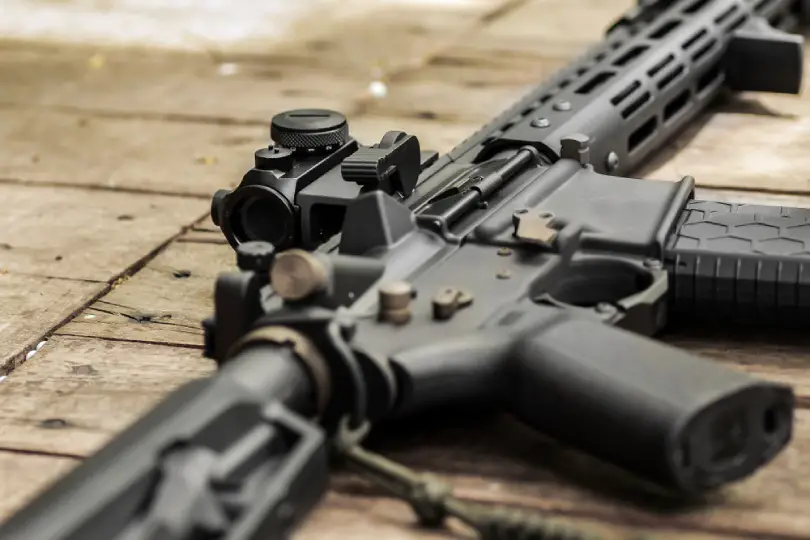







Leave a Comment